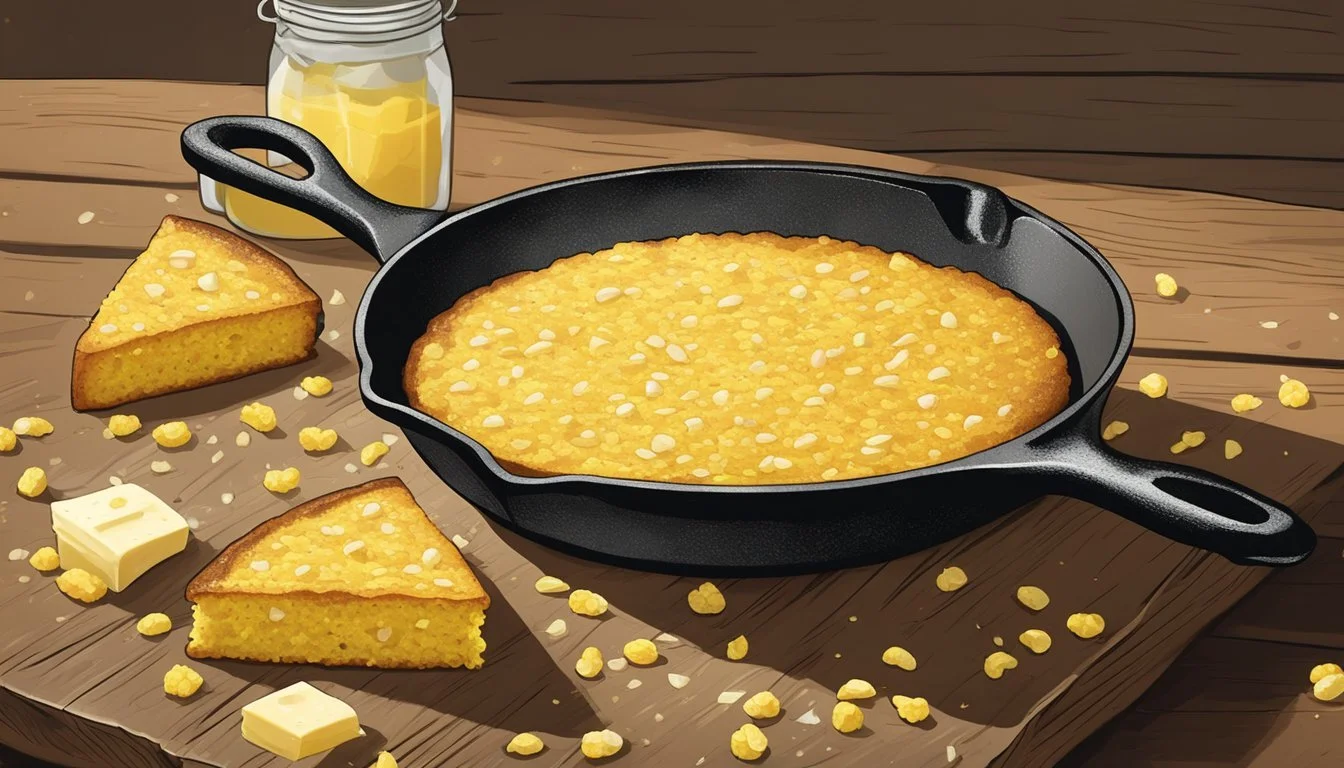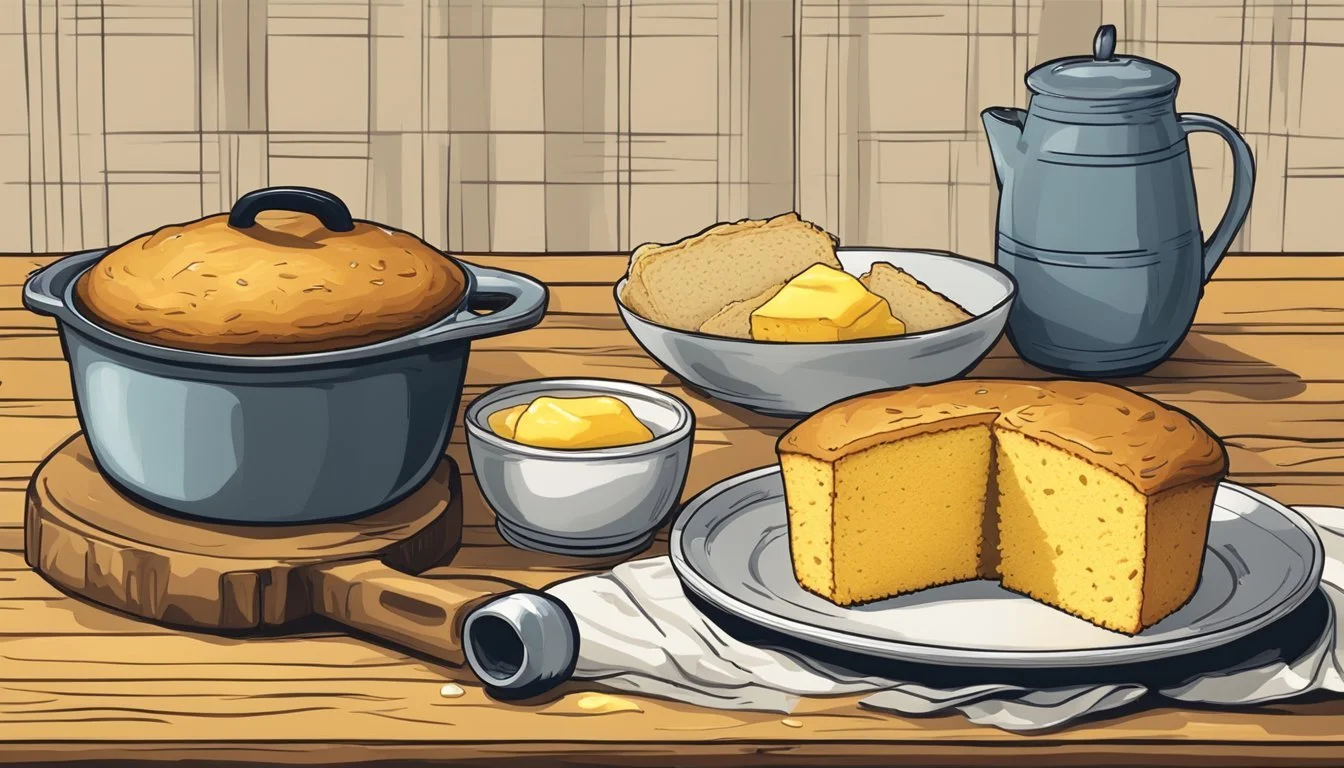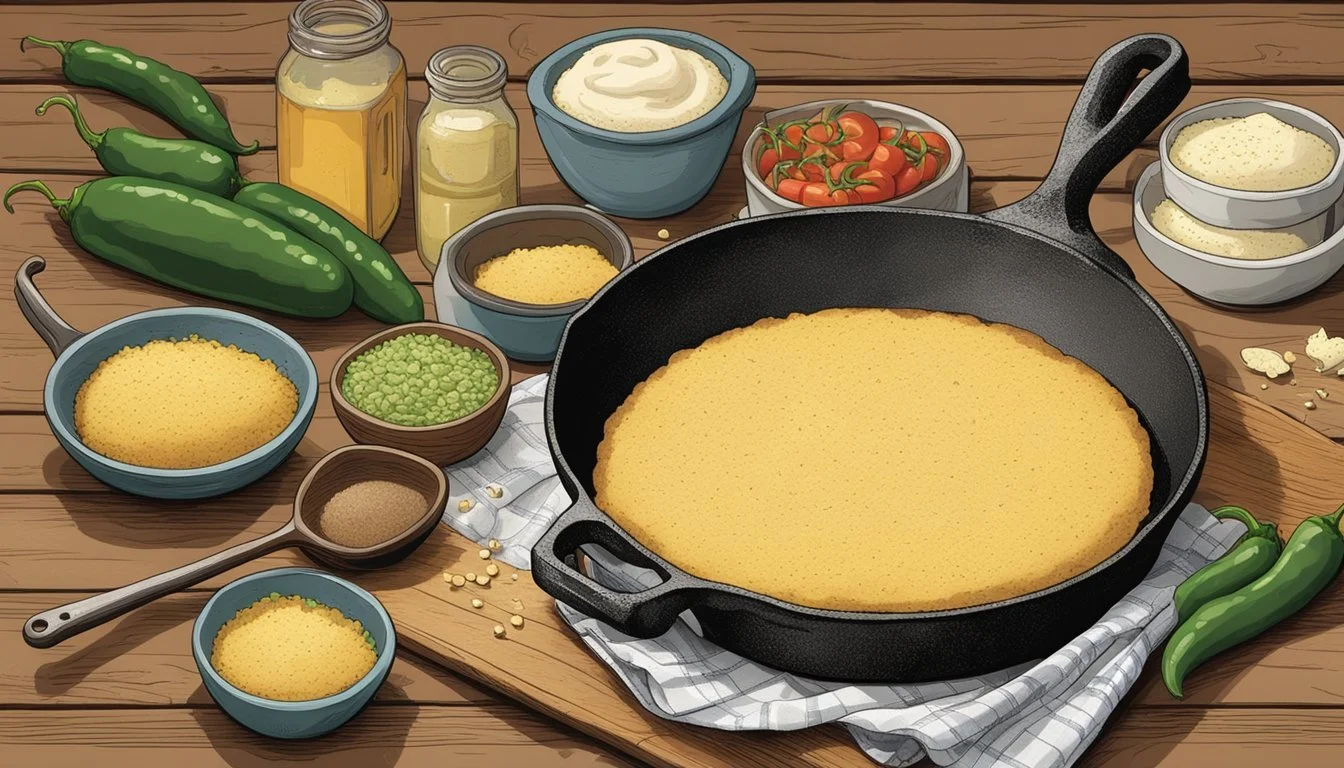How to Make Cornbread That Texans Will Love
A Guide to Authentic Southern Flavors
Cornbread holds a special place in the hearts of Texans, embodying a tradition that is both rustic and timeless. To craft a cornbread that resonates with the Texan palate, one must embrace simplicity and eschew the temptation to sweeten the bread, as sweetness is often frowned upon in classic Texan recipes. Authentic Texas cornbread is known for its crispy exterior and fluffy interior, a balance achieved by the use of a hot cast-iron skillet that is as essential to the process as the ingredients themselves.
The key to exceptional cornbread lies in the preparation and the heat of the oven. A cast-iron skillet is not only traditional but also instrumental in creating that coveted crust that Texans adore. The skillet is greased and then preheated in the oven, ensuring that the batter starts cooking the moment it touches the pan, resulting in a crispy foundation. The batter itself is a straightforward mix, relying on high-quality cornmeal, flour, baking powder, and salt. A combination of buttermilk and eggs is often added to the dry ingredients to lend the bread moisture and a slight tang, enhancing the overall flavor without overpowering the cornmeal's subtle, earthy notes.
Temperature and timing are critical, with most recipes calling for a hot oven, usually between 375°F and 450°F, which helps the cornbread rise quickly and evenly. Texans expect their cornbread to be not just an accompaniment to chili, barbecues, and stews but a standout dish in its own right, with a texture that's equally at home soaking up sauces or served with a drizzle of melted butter and molasses. Whether served in wedges like a pie or as a hearty side, Texas cornbread is a testament to the state's culinary heritage, and making it right is a matter of pride.
Understanding Cornbread
Cornbread is a traditional Southern American staple, steeped in history and regional variations. In essence, it's a type of bread made primarily from cornmeal, which gives it a distinctive texture and flavor. Its origins trace back to Native American cuisine, which was adapted by European settlers with the introduction of wheat flour and baking powder.
Texas Cornbread, in particular, is known for its savory profile, often containing ingredients such as jalapeños, cheese, and buttermilk, reflecting the bold flavors of Texan cuisine. Unlike Southern Cornbread, which is characteristically made from just cornmeal, buttermilk, and lard or bacon fat, Texas cornbread may integrate a blend of cornmeal and wheat flour, resulting in a sturdier, less crumbly texture.
While there's a debate regarding Sweet Cornbread—which is more commonly associated with Northern American preferences—traditionalists often argue that true Southern and Texas variations are not supposed to be sweet. As a neutral party, it's important to recognize that both sweet and unsweetened cornbreads have their own appeal and devoted followings.
From a nutrition standpoint, cornbread can contribute to a balanced diet. It's a good source of carbohydrates, fiber, and essential nutrients like niacin and vitamin B6. However, additions such as sugar, butter, and cheese can increase the calorie count. Cornbread can complement many dishes, such as chili, barbecued meats, (What wine goes well with barbecued meats?) and vegetables, making it a versatile addition to meals.
In short, understanding cornbread requires appreciation of its cultural and historical context, regional variations, and nutritional content. Texas cornbread is just one delicious page of this rich culinary story.
Essential Ingredients
The crafting of authentic Texas cornbread hinges on a select repertoire of ingredients. Precision in measurement and the quality of the components lay the foundation for a delectable result that Texans will undoubtedly appreciate.
Measuring the Basics
To create a quintessential batch of Texas cornbread, one starts with all-purpose flour, cornmeal, sugar, salt, baking powder, and baking soda. These staples ensure the bread rises correctly, has a pleasant texture, and achieves the right balance of sweetness to complement the corn flavor.
Flour: 1 to 1 1/2 cups (for a firm structure)
Cornmeal: 1 to 2 cups (for authentic corn flavor)
Sugar: 1 to 2 tablespoons (optional, depending on sweetness preference)
Salt: 1 teaspoon (to enhance flavors)
Baking powder: 1 tablespoon (for rise)
Baking Soda: 1/4 teaspoon (to interact with acidic ingredients, like buttermilk, for leavening)
Choosing Cornmeal
The heart of cornbread is cornmeal, and its selection is crucial. For Texas cornbread, one typically uses a medium to coarse-ground meal, which provides the expected gritty texture. A cornbread aficionado might even opt for stone-ground cornmeal for an authentic rustic touch.
The Role of Fats
Fats are pivotal in achieving the moist and tender crumb that cornbread enthusiasts savor. Butter is traditionally used for its rich flavor, often melted in a skillet before adding the batter. Additionally, cheese may be incorporated for a savory twist, with choices ranging from mild cheddar to sharp varieties. Egg and milk (or buttermilk) bind the ingredients together and contribute to the moisture content.
Butter: 1/4 to 1/2 cup (for flavor and to grease the pan)
Egg: 1 large (as a binder)
Milk/Buttermilk: 1 cup (to hydrate the batter; buttermilk adds a tangy flavor)
Cheese: 1/2 cup shredded (optional for a cheesy variant)
By adhering to these ingredient guidelines, one is well-equipped to prepare a cornbread that resonates with the palates of Texans.
Equipment and Preparation
Making a truly Texan cornbread starts with the right equipment and preparation method. These initial steps are crucial for achieving that perfect, crusty exterior and soft interior that is characteristic of the dish.
Selecting a Skillet
The right skillet is key in preparing cornbread. A cast-iron skillet is traditionally used, as it retains heat well and imparts a unique flavor. Its ability to go from stovetop to oven makes it highly versatile. For those who don't have a cast-iron skillet, a baking dish or baking pan can also be used, although results may vary.
Preheat Oven Techniques
Preheating the oven is an important step that shouldn't be skipped. It ensures that the cornbread starts cooking immediately and helps it to rise properly. The temperature typically ranges from 325 degrees to 425 degrees depending on the recipe. One preheating technique includes heating the skillet or baking dish in the oven before adding the batter. This helps in creating a crispy crust. Remember to coat the skillet or baking dish with cooking spray or butter to prevent sticking. Meanwhile, one can combine the dry and wet ingredients in a large bowl to ensure a quick assembly once the oven reaches the desired temperature.
Mixing and Baking
Achieving the perfect blend of ingredients and baking them to the right degree of doneness are crucial steps in creating cornbread that Texans will approve of. Precision in measuring and timing can make the difference between an average and an outstanding cornbread.
Combining the Ingredients
One begins the process by whisking together the dry ingredients—cornmeal, flour, sugar, baking powder, and baking soda—in a large mixing bowl. This provides an even distribution that is foundational to the cornbread's texture. In a separate container, one whisks the wet ingredients—ideally consisting of buttermilk for tanginess and richness, canola oil or melted butter for moisture, and large eggs for structure.
After combining the two, it is essential to stir the mixture just enough to integrate; overdoing it can result in a tough cornbread. For a true Texan touch, ingredients like jalapeños or shredded cheese may be folded in at this stage for additional flavor.
Baking to Perfection
Preparing the oven is the next critical step. Texans often favor a hot oven, so one should preheat it to between 375°F to 450°F depending on the recipe specifics. For a crusty exterior, melting butter in a cast-iron skillet inside the oven before adding the batter is a traditional method. It also prevents sticking.
Once the oven reaches the desired temperature, the cornbread batter is poured into the heated pan or a greased baking dish. It then bakes until the edges are golden brown and a toothpick inserted in the center comes out clean—which commonly takes about 20 to 25 minutes. Monitoring the cornbread as it bakes is key, as ovens may vary in temperature. When finished, the cornbread should rest briefly before serving to allow easier slicing.
Texan Twists
To make cornbread that garners the nod of approval in Texas, one needs to embrace bold flavors typical of the Texan palate. These twists involve integrating jalapeños, whole kernel corn, and a generous addition of cheeses, ensuring each bite is packed with taste and texture.
Spicing with Peppers
When it comes to adding heat, Texans often turn to jalapeños or green chiles. A finely diced jalapeño pepper mixed into the batter distributes a spicy kick throughout the cornbread. For a milder flavor, one can opt for green chiles, which offer a subtle warmth and a hint of vegetal notes.
Jalapeños: Add 1-2 finely chopped peppers (depending on size and desired heat level) to the batter.
Green Chiles: Stir in a half cup of diced green chiles for a tangier taste.
Adding Whole Corn
Yellow Corn and Whole Kernel Corn contribute texture and sweetness to the classic cornbread recipe. Drained sweet corn or whole kernel corn adds bursts of juiciness, creating a more substantial bite that contrasts the bread's crumbly nature.
Yellow Corn: Incorporate a half cup of drained yellow corn for a natural sweetness.
Whole Kernel Corn: Use half a cup to provide a pleasing pop in each slice.
Incorporating Cheeses
Lastly, cheese is a welcome addition to Texan cornbread. Cheddar Cheese is a common choice, melting into the bread and providing a sharp, creamy flavor that complements the aforementioned peppers and corn.
Cheddar Cheese: Mix in a half cup of shredded mild cheddar to the batter before baking to create a gooey, flavorful texture.
Serving Suggestions
When it comes to cornbread, Texans appreciate it for its versatility, whether it's the star of breakfast or a hearty addition to dinner. The following suggestions ensure that the cornbread is presented with accompaniments that enhance its flavors and add to the experience.
Accompanying Dishes
Texans often enjoy cornbread alongside robust, savory dishes. For a classic Texan dinner, Chili is a match made in heaven with cornbread, providing a combination of textures and flavors that complement each other perfectly. Another hearty option is serving cornbread with Soup, especially during colder months, offering a comforting meal.
Dinner
Chili
Soup
Breakfast
Scrambled eggs
Breakfast sausage
Presentation and Toppings
Cornbread's presentation should be simple yet inviting. When serving, one can cut the cornbread into neat squares or wedges, ensuring each piece has a crispy edge and a soft center. As for toppings, a pat of butter melting atop a warm slice is a classic touch, but one might also consider drizzling Honey for a sweet juxtaposition against the savory bread. In Texas, it's also common to add a dollop of Jam for a balance of flavors, making it suitable for Dessert.
Toppings
Butter (essential)
Honey (for sweetness)
Jam (for a dessert-like finish)
By keeping these suggestions in mind, cornbread can be served in a manner that will have Texans nodding with approval at any meal.
Cornbread Variations
The versatility of cornbread allows it to be adapted to various tastes and preferences, ranging from sweet to savory, and cooked using different methods to yield a range of textures and flavors.
Skillet Cornbread
Skillet Cornbread, a Southern staple, is known for its golden crust and tender crumb. Ingredients like melted butter create a rich base while a hot cast-iron skillet ensures the outer layer crisps beautifully. This homemade cornbread is simple to make, often involving a mix of cornmeal, eggs, and buttermilk. It's cooked in a preheated, buttered skillet, marrying the ease of preparation with the tradition of Southern cooking.
Hot Water Cornbread
Hot Water Cornbread is a minimalist, rustic variation often found in Southern kitchens. The batter is made from a mixture of cornmeal, hot boiling water, and salt, resulting in a firm texture suitable for shaping into patties. They're typically fried until a crunchy exterior forms, making them the perfect side for dishes with gravy or sauce.
Sweet Versus Savory
There's a divide in the cornbread world between sweet and savory versions.
Sweet Cornbread:
Uses ingredients like sugar or honey, appealing to those who enjoy a bit of sweetness in their bread.
It may feature creative additions like a lemon-honey glaze or fruits such as figs.
Savory Cornbread:
Incorporates flavorful ingredients such as jalapenos for a spicy kick or sour cream for added moisture and tang.
Pairs exceptionally well with chili, stews, or as a stand-alone treat with a slather of butter.
Storage and Leftovers
Storing cornbread properly ensures it retains its moisture and flavor, making it just as enjoyable the next day. Leftovers should be cooled to room temperature before storage to prevent condensation which can lead to sogginess.
Once cooled, they recommend placing the cornbread in an airtight container to maintain freshness. If storing at room temperature, it should be consumed within 1-2 days. To extend its shelf life, they suggest refrigeration as a viable option. Properly sealed, cornbread can last up to a week in the fridge.
Freezing the cornbread is ideal for long-term storage. One can wrap individual slices or the entire batch in plastic wrap followed by aluminum foil to protect against freezer burn. It's important to label the package with the date, as cornbread can be frozen for up to three months.
When it comes to Reheating, they recommend an oven or toaster oven to best restore the cornbread's fresh-baked qualities. One should preheat the oven to 350°F and wrap cornbread in foil. Heat it for a few minutes until warmed through. For those in a hurry, the microwave can be used with caution — a damp paper towel wrapped around the bread helps to reintroduce moisture, reheating it briefly on a medium setting to avoid toughness.
Here's a simple table summarizing the storage recommendations:
Storage Method Duration Notes Room Temperature 1-2 days Cool completely, use airtight container Refrigeration Up to 1 week Seal in an airtight container Freezing Up to 3 months Wrap in plastic wrap and foil, label with date
Remember, attentive storage and proper reheating will keep the cornbread tasting as if it's fresh out of the oven, ready to satisfy even the most discerning Texan palates.
Troubleshooting Common Issues
It's essential for the baker to address common issues that can arise when making cornbread. This ensures a perfect Texas-style cornbread that's neither too dry nor undercooked.
Avoiding a Dry or Crumbly Texture
To prevent a dry or crumbly texture, one must strike a balance between wet and dry ingredients. The baker should use buttermilk to add richness and moisture. Additionally, they can consider adding a small amount of creamed corn for extra moisture and texture. It is crucial not to overmix the batter and to stick to the recommended cooking time to avoid overbaking, which leads to dryness.
Preventing a Soggy Bottom
To prevent a soggy bottom, the baker must ensure proper skillet maintenance. Preheating the skillet in the oven before adding the batter will promote a quick and even cooking start, which helps to create a crisp bottom crust. Cooking spray or butter should be used to grease the skillet, but the baker should avoid any excess to prevent sogginess.
Ensuring Even Cooking
For even cooking, it's advisable to use a heavy, well-seasoned cast-iron skillet. It's known for its heat retention and distribution properties. The skillet should be placed in the center of the oven where the temperature is most stable. If the batter is particularly thick, the baker may need to reduce the oven temperature slightly and increase the cooking time to ensure the cornbread cooks through without burning on the top or edges.






